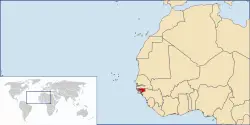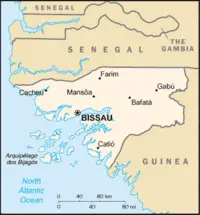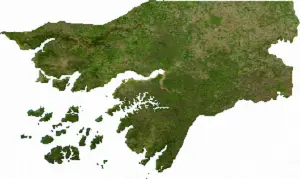Guinea-Bissau
| República da Guiné-Bissau Republic of Guinea-Bissau | |||||
| |||||
| Motto: "Unidade, Luta, Progresso" (Portuguese) "Unity, Struggle, Progress" | |||||
| Anthem: Esta é a Nossa Pátria Bem Amada (Portuguese) | |||||
| Capital | Bissau1 11°52′N 15°36′W | ||||
|---|---|---|---|---|---|
| Largest city | capital | ||||
| Official languages | Portuguese | ||||
| Government | Republic | ||||
| - President | João Bernardo Vieira | ||||
| - Prime Minister | Martinho Ndafa Kabi | ||||
| Independence | from Portugal | ||||
| - Declared | September 24 1973 | ||||
| - Recognised | September 10 1974 | ||||
| Area | |||||
| - Total | 36,125 km² (136th) 13,948 sq mi | ||||
| - Water (%) | 22.4 | ||||
| Population | |||||
| - July 2005 estimate | 1,586,000 | ||||
| - 2002 census | 1,345,479 | ||||
| - Density | 44/km² 114/sq mi | ||||
| GDP (PPP) | 2005 estimate | ||||
| - Total | $1.167 billion | ||||
| - Per capita | $736 | ||||
| HDI (2004) | |||||
| Currency | CFA franc (XOF)
| ||||
| Time zone | GMT (UTC+0) | ||||
| Internet TLD | .gw | ||||
| Calling code | +245 | ||||
Guinea-Bissau, officially the Republic of Guinea-Bissau, is one of the smallest nations in continental Africa. Formerly the Portuguese colony of Portuguese Guinea, upon independence, the name of its capital, Bissau, was added to the country's official name in order to prevent confusion with the Republic of Guinea.
Guinea-Bissau is one of the world's poorest countries, with more than two-thirds of its population living below the poverty line. The economy depends mainly on agriculture and fishing, and cashew nuts are its major exports. A long period of political instability has resulted in depressed economic activity and deteriorating social conditions.
Geography
Guinea-Bissau is bordered by Senegal to the north, Guinea to the south and east, and the Atlantic Ocean to its west. At 13,945 sq mi. (36,120 km²), it is nearly identical in size to Taiwan and somewhat larger than the U.S. state of Maryland.
This small, tropical country lies at a low altitude; its highest point is 984 feet (300 m). The interior is savanna, and the coastline is swampy plain. Its monsoon-like rainy season alternates with periods of hot, dry harmattan winds blowing from the Sahara Desert. The Bijagos Archipelago extends out to sea.
History
Guinea-Bissau was once the kingdom of Gabù, part of the Mali Empire. Although the rivers and coast of this area were among the first places colonized by the Portuguese, who began exporting slaves in the seventeenth century, the interior was not explored until the nineteenth century.
An armed rebellion beginning in 1956 by the African Party for the Independence of Guinea and Cape Verde (PAIGC) under the leadership of Amílcar Cabral gradually consolidated its hold on the country. Unlike other Portuguese anticolonial efforts, the PAIGC rapidly extended its military control over large portions of the country, aided by the jungle-like terrain and large quantities of arms from Cuba, China, the Soviet Union, and other African countries. Cuba also agreed to supply artillery experts, doctors, and technicians. The PAIGC even managed to acquire a significant anti-aircraft capability to defend itself against aerial attack. By 1973, the PAIGC controlled most of the country. Independence was unilaterally declared on September 24, 1973, and was recognized by a 93-7 UN General Assembly vote in November 1973. Recognition became universal following the 1974 socialist-inspired military coup in Portugal.
Guinea-Bissua was controlled by a revolutionary council until 1984. The first multiparty elections were not held until 1994, but an army uprising in 1998 led to the president being ousted and the Guinea-Bissau civil war. When elections were held in 2000, Kumba Ialá was elected president.
In September 2003, a coup took place in which the military arrested Ialá on the charge of being "unable to solve the problems." After being delayed several times, legislative elections were held in March 2004. A mutiny of military factions in October 2004 resulted in the death of the head of the armed forces and caused widespread unrest.
In June 2005, presidential elections were held for the first time since the coup that deposed Ialá. Ialá returned as a candidate, claiming to be the legitimate president, but the election was won by former president João Bernardo Vieira, who had been deposed in the 1998 coup. Vieira, a candidate for one faction of the PAIGC, defeated Malam Bacai Sanha in a runoff election. Sanha initially refused to concede, charging that the elections were fraudulent in two constituencies, including the capital Bissau.
Despite reports that there had been an influx of arms in the weeks leading up to the election and reports of some 'disturbances during campaigning' - including attacks on the presidential palace and the Interior Ministry by as-yet-unidentified gunmen - European monitors described the election as "calm and organized." [1]
Politics
Guinea-Bissau is a republic. In the past, the government has been highly centralized and multiparty governance has been in effect since mid-1991. The president is the head of state and the prime minister is the head of government. At the legislative level, there is a unicameral National People's Assembly made up of 100 members. They are popularly elected from multi-member constituencies to serve a four-year term. At the judicial level, there is a Supreme Court, which consists of nine justices appointed by the president. They serve at the pleasure of the president.
João Bernardo "Nino" Vieira became president of Guinea-Bissau in 2005, returning to power only six years after being ousted from office during a civil war. Previously, he held power for nineteen years after taking power in 1980 in a bloodless coup. In that action, he toppled the government of Luís Cabral.
Politics
Guinea-Bissau is a multiparty republic. Since its 1974 independence from Portugal, Guinea-Bissau has experienced much political, social, and military upheaval. A 2003 coup attempt upset the already tenuous situation in the nation. The election of João Bernardo Vieira as president marked the path back to constitutional government.
The government works to respect the civil and human rights of its citizens. However, dire economic and social conditions hinder stability in the region.
The government uses suppression of political opposition and purging of political dissidents to maintain its control. The police are known to use violent means when dispersing otherwise peaceful demonstrations. Human rights activists are often arrested and beaten due to the work they are trying to promote.
The abuse of children, including child labor, continues to be a problem in the region. Child trafficking is also an issue.
Administrative divisions
Guinea-Bissau is divided into eight regions and one autonomous sector. These in turn are subdivided into thirty-seven sectors.
Economy
Guinea-Bissau gained its independence from Portugal in 1974 after a protracted liberation war that brought tremendous damages to the country’s economic infrastructure. The civil war that took place in 1998 and 1999 and a military coup in September 2003 again disrupted economic activity, leaving a substantial part of the economic and social infrastructure in ruins and intensifying the already widespread poverty. Following the parliamentary elections in March 2004 and presidential elections in July 2005, the country is trying to recover from the long period of instability despite a still-fragile political situation.
Guinea-Bissau is one of the world's poorest countries, with more than two-thirds of its population living below the poverty line. The economy depends mainly on agriculture and fishing, and cashew nuts are its major exports. A long period of political instability has resulted in depressed economic activity, deteriorating social conditions, and increased macroeconomic imbalances. The key challenges for the country in the period ahead will be to restore fiscal discipline, rebuild public administration, improve the climate for private investment, and promote economic diversification.
Demographics
The population of Guinea-Bissau is ethnically diverse and has many distinct languages, customs, and social structures. Nearly 99 percent of Guineans are black and can be divided into the following three categories: Fula and the Mandinka-speaking people, who comprise the largest portion of the population and are concentrated in the north and northeast; the Balanta and Papel people, who live in the southern coastal regions; and the Manjaco and Mancanha, who occupy the central and northern coastal areas. Most of the remaining 1 percent are mestiços of mixed Portuguese and black descent, including a Cape Verdean minority. Pure Portuguese comprise only a very small portion of Guinea-Bissauans. This deficit was directly caused by the exodus of Portuguese settlers that took place after Guinea-Bissau gained independence. The country also has a Chinese minority, including Macanese people of mixed Portuguese and Chinese blood from Macau. Only 14 percent of the population speaks the official language, Portuguese; another 44 percent of the population speaks Kriol, a Portuguese-based creole language, and the remainder speaks native African languages. Pure-blooded Portuguese and mestiços speak one of the African languages and Kriol as second languages. French is also learned in schools, as the country is a member of La Francophonie. Most people are farmers with traditional religious beliefs (animism); 45 percent are Muslim, principally the Fula and Mandinka peoples; and less than 8 percent are Christian, most of whom are Roman Catholic.
Culture
Music
The music of Guinea-Bissau is usually associated with the polyrhythmic gumbe genre, the country's primary musical export. However, civil unrest and a small size have combined over the years to keep gumbe and other genres out of mainstream audiences, even in generally syncretist African countries.
The calabash is the primary musical instrument of Guinea-Bissau, and is used in extremely swift and rhythmically complex dance music. Lyrics are almost always in Guinea-Bissau Creole, a Portuguese-based creole language, and are often humorous and topical, revolving around current events and controversies, especially AIDS.
The word gumbe is sometimes used generically, to refer to any music of the country, although it most specifically refers to a unique style that fuses about ten of the country's folk music traditions. Tina and tinga are other popular genres, while extent folk traditions include ceremonial music used in funerals, initiations and other rituals, as well as Balanta brosca and kussundé, Mandinga djambadon and the kundere sound of the Bijagos islands.
Matriarchy
In the Bolama archipelago, a matriarchal or at least matrilineal social system has survived to the present day[2], although it is currently being eroded by globalization and Christian missionary influence.
In this system, women choose husbands who are compelled to marry them, and religious affairs are controlled by a female priesthood.
ReferencesISBN links support NWE through referral fees
- Richard Andrew Lobban, Jr. and Peter Karibe Mendy, Historical Dictionary of the Republic of Guinea-Bissau, third ed. (Scarecrow Press, 1997) ISBN 0-8108-3226-7 Includes extensive bibliography
External links
News
- allAfrica - Guinea Bissau news headline links
Overviews
Directories
- Open Directory Project - Guinea Bissau directory category
- Stanford University - Africa South of the Sahara: Guinea-Bissau directory category
- The Index on Africa - Guinea-Bissau directory category
- University of Pennsylvania - African Studies Center: Guinea-Bissau directory category
- Yahoo! - Guinea-Bissau directory category
Other links
- Map of Guinea-Bissau
- United States consular information sheet/travel advisory for Guinea-Bissau
- (Portuguese) Devaneios Desintéricos - Oil in Guinea Bissau?
- [3]
Credits
New World Encyclopedia writers and editors rewrote and completed the Wikipedia article in accordance with New World Encyclopedia standards. This article abides by terms of the Creative Commons CC-by-sa 3.0 License (CC-by-sa), which may be used and disseminated with proper attribution. Credit is due under the terms of this license that can reference both the New World Encyclopedia contributors and the selfless volunteer contributors of the Wikimedia Foundation. To cite this article click here for a list of acceptable citing formats.The history of earlier contributions by wikipedians is accessible to researchers here:
The history of this article since it was imported to New World Encyclopedia:
Note: Some restrictions may apply to use of individual images which are separately licensed.




